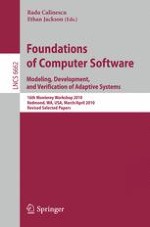This book presents the thoroughly refereed and revised post-workshop proceedings of the 16th Monterey Workshop, held in Redmond, WA, USA, in March/April 2010. The theme of the workshop was Foundations of Computer Software, with a special focus on Modeling, Development, and Verification of Adaptive Systems. The 13 revised full papers presented were carefully reviewed and selected from numerous submissions for inclusion in the book. The contributions show how the foundations and development techniques of computer software could be adapted even for industrial safety-critical and business-critical applications to improve dependability and robustness and to ensure information privacy and security.
